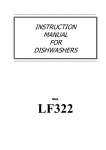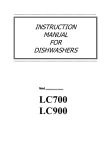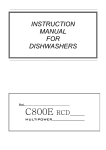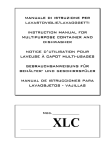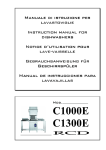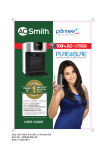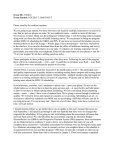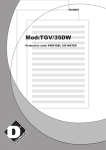Download RF Series - Commercial Warewasher
Transcript
INSTRUCTION MANUAL FOR DISHWASHERS Mod. RF321____________ INSTRUCTIONS FOR THE USER FOREWORD 1. Read the instructions contained in the enclosed booklet carefully, because it contains important information on installation, operation and maintenance safety. Store this booklet carefully for any further consultation by other operators. 2. Having removed the packing material, check that all the equipment is present. If there is any doubt, do not use it and contact qualified personnel. The packing elements (plastic bags, foam polystyrene, nails, etc.) should be kept away from children, because they are dangerous. 3. Before switching the equipment on, make sure that the model plate data conforms to that of the electrical and water distribution network. 4. Installation should be carried out by qualified personnel according to the manufacturer's instructions. 5. This equipment should be destined to the use which it has been conceived for. Any other application should be considered improper and consequently dangerous. 6. The equipment should only be used by personnel trained for its use. 7. Operators must strictly follow all hygienic requirements in the handling of clean dishware and cutlery. 8. Do not leave the machine in an environment at temperatures lower than 0°C. 9. The protection of the machine is IP X4, therefore it should not be washed with high pressure directed water jets. 10.Qualified personnel only can access the control panel, after having disconnected the machine from the primary current supply. 11.The appliance is made according to EEC 89/336 regarding radio noise suppression and electromagnetic compatibility. 12.According to EEC directive nr.23 of 19/02/1973 and the law of actuation nr.791 of 18/10/1987, our appliances are built-up according to the good technique norms in force in Italy and abroad. 13.Noise level of the machine, less than 63dB(A) 2 INSTRUCTIONS FOR THE USER INSTRUCTIONS FOR USE 3 INSTRUCTIONS FOR THE USER CONTROL PANEL H2 H3 Q1 S3 H2 H3 Pilot lamp "machine READY" Pilot lamp "machine WORKING" Q1 GREEN RED RED Main switch Machine off Machine on / Start cycle Machine on / Drain position S3 Push button "CYCLE START" S I Plug Regulating screw for rinse aid injector 4 INSTRUCTIONS FOR THE USER OPERATION AND USE 1. Before washing make sure that: • the wall-mounted on/off switch is switched on; • the water tap is open; • water is present in the distribution network; • the pump protection filters are installed in their respective positions; • the overflow in inserted; • all rotating parts are free; • the rinse aid dispenser is full; • make sure that dishware is in good conditions as it may cause cleaning difficulty and haven bacteria. 2. Press switch "Q1" to position "RED" to enable the automatic wash tank filling and the consequent triggering of the heating element. 3. As soon as visual indicator "H2" is ON; pour about 30 gr. of detergent directly into the tank, paying attention to distribute it uniformly on the filters, the quantity being according to supplier's instructions. Add 15 gr. every 7 cycles to achieve a concentration of 1,5 gr./lt. In order to respect our environment, use only the correct amount of detergent. When using chlorinated detergent, it is suggested to use an automatic dispenser; otherwise, brownish spots might appear on the surfaces due to chlorine reactions. Detergent should always be placed near the pump filter. 4. Then, introduce the glasses or the cups to wash, after having removed the solid waste and having placed them into the proper racks. The cups and the glasses should be turned upside down, while the cutlery should be put vertically into the proper container, and the same applies to dishware. 5. Close the door and press the "S3" button to start cycle, the end of which will be indicated by the switching off of the "H3" lamp. ATTENTION: Machine in conformity with the existing hygienic standards, guaranteeing a final rinse at 85°C. Wash cycle automatically lengthened if final rinse temperature is not reached.When this auto-cycle intervenes and the cycle is pro-longed, after 8 minutes the "H3" indicator flashes to indicate this intervention and the cycle continues (water supply temperature is likely to be the problem, otherwise contact an assistance center since it is a rinse water heating intervention.). Turn off the machine to remove this alarm. 5 INSTRUCTIONS FOR THE USER 6. Remove the rack and slightly incline it to permit a perfect drain; allow dishware to dry and after having washed one’s hands, handle the rack in order not to touch the dishware inside then place the rack on hygienically clean shelves. 7. At the end of washing, open the door, empty out the tank by taking out the overflow tube, then close the door for a few minutes to wash the machine. Then again put the switch "Q1" in position "GREEN" and wait until the tank is completely empty. Machines with drain pump, with switch "Q1" in position "RED" and the door open, simply push the "S3" button (for 3sec.) for the drain cycle, automatically the machine will carry out the drain cycle for 2 minutes and 20 seconds. The "H3" lamp is on. At this point, the tank filter can be taken out, in order to be washed, then replace it with the overflow in its place. (For further use , first switch off the machine). For any further information concerning equipment cleaning, read chapter "USEFUL SUGGESTIONS". When the washing is finished, switch off the equipment by 8. turning off the main supply through the general wall switch and close the water supply. 6 INSTRUCTIONS FOR THE USER INSTRUCTIONS DURING THE WASHING 1)Do not plunge bare hands into the water containing the detergent. If this happens, wash them immediately and abundantly with fresh water. 2)When the machine is operating, do not open the door too rapidly. 3)Use only specific anti-foaming detergents. 4)Disconnect the equipment in case the machine is out of order or it does not work properly. For the repairs consult a technical assistance centre authorised by the manufacturer and ask only for an original spare parts. 5)Never modify the thermostat settings. 6)Check that lamp "H2" is on. 7)Wash tank water should be changed at least twice a day or according to daily wash requirements. 8)Do not subject clean dishware to any further cleansing treatment such as brushes or drying towels. If these instructions are not followed, the safety of the equipment can be compromised. 7 INSTRUCTIONS FOR THE USER USEFUL SUGGESTIONS 1) MAINTENANCE IMPORTANT: Before carrying out the cleaning and maintenance operations, disconnect the equipment from the electric supply. Frequently check and clean the nozzles. The frequency of this operation will depend on the quantity of residues, which may result in an unsatisfactory washing result. ♦ For the inside and outside cleaning of the machine, do not use corrosive products such as sodium hypochlorite (bleach) savelling water and hydrochloric acid, acids, steel wool or steel brushes. ♦ The presence of calcium and magnesium salt in the water can compromise machine performance, thus ask qualified personnel to remove the deposits periodically. ♦ In order to avoid some oxidation risks, or chemical reactions, generally the stainless steel surfaces have to be well cleaned. 2) OPTIMAL RESULTS: A possible wash deficiency can be noticed when residue remains. Marks can be caused by an insufficient rinse: in this case check that the rinse nozzles are clean and that there is sufficient water supply pressure. In case of dishware residue check that: • the washing nozzles are clean • the water temperature is around 60°C • there is detergent • the pump suction filter is clean • the racks are suitable for the dishes and cutlery that are to be washed • the position of the cutlery and the dishes in the racks are correct 3) TEMPORARY MACHINE NON-USE In case the machine is stopped for some weeks, it is recommended before closing it to fill the tank and run the machine with clean water, then empty it out, in order to avoid the forming of bad odour and that any residue remains in the pump. If necessary repeat this operation until the water leaving the machine is clean. If the machine is stopped for many weeks, it is recommended to oil the stainless steel surfaces with paraffin oil and to discharge the water from the boiler and the electric pump. 8 INSTRUCTIONS FOR THE USER 4)SANITIZING THE MACHINE Sanitizing the machine at least once a week is of the utmost importance in order to guarantee hygiene even when the machine is not in use. It is advisable to use a disinfecting product suggested by an authorised detergent dealer. The use of this product will satisfy hygienic requirements, even during machine non use. Before switching off the machine run the machine briefly with clean water. 5)HARD WATER CONDITIONS If a hard water supply is present, mineral deposits will form within the machine and also on dishware. In order to avoid the above conditions a periodic removal of these deposits is necessary. The frequency and method of this operation upon consultation by your detergent supplier. 9 INSTALLATION AND MAINTENANCE INSTRUCTIONS The following instructions are addressed to a qualified personnel the only one authorised to carry out checks and repairs, if any. The manufacturer declines any responsibility in the case of interventions made by a non qualified personnel or the use of spare parts other than those supplied by the Manufacture. 10 INSTRUCTIONS FOR TECHNICAL PERSONNEL INSTALLATION During installation, carry out proper machine levelling, which is a prerequisite for a correct operation thereof (max. tolerance 2°). In order to prevent any damage caused by steam going out of the machine, make sure that the surrounding materials do not deteriorate in its presence. After machine installation check thermostat settings, booster 85°C, tank 60°C. 1)ELECTRICAL CONNECTION The electrical safety of this equipment is only assured if it is connected as follows. It is necessary to connect the equipment to an effective earthing as specified by the electrical safety regulations in force. Check that this basic requirement is complied with, in case of any doubt ask for a careful check of the installation by a qualified personnel. In the case the earthing is not efficient there will be a dispersion due to the suppresser. The machine shall be included in a correctly dimensioned equipotential, whose effectiveness is to be very tight in accordance to the procedures set for in the applicable safety standards. The connection shall be performed through a screw marked by the plate near the rear side of the appliance. The manufacturer declines any responsibility for any damages caused by lack of an effective ground installation. For the electrical power supply have available a wall circuit breaker switch with multiple phase protection according the following table with contact aperture distance, equal to or not exceeding 3mm and a supply cable suitable. Mod. RF321 220/230V∼ ∼ 220/230V 3∼ ∼ 16A 16A 380/400V 3N∼ ∼ 10A For other supplies the cable cross section and the circuit breaker switch must be calculated according to voltage and length of cabling. If cabling too long adjust cable size to Amp rating; do not pull on supply cable or install it under tension. If cable needs to be replaced use type H07RN-F and a section suitable. 11 INSTRUCTIONS FOR TECHNICAL PERSONNEL 2)WATER CONNECTION Install a 55°C water tap in a well accessible place, terminating in a 3/4" fitting, which the pipe strainer and inlet hose shall be connected to. Carefully comply with any national or regional regulations in force. The operating pressure should be neither less than 2 bars or greater that 4 bars (200/400 kPa). If water pressure is inferior then 2 bar, a pressure increase pump is necessary. If water pressure exceeds 4 bar, a pressure reducer is necessary. In order to obtain best results, it is suggested that the water supply have a hardness not greater that 8 Clarke. 3)WATER DRAIN Arrange a water drain towards the floor with siphon and connect the machine with the flexible tube given with the machine, so that it leans towards the drain. Moreover, make sure that the hose does not have constrictions. Make sure that the building drain tubing withstands temperatures up to 70°C. 4)RINSE AID DOSAGE Make sure that rinse aid suction hose is correctly installed in it’s proper container. The dosage is automatic with the adjusting of the screw "I", which after screwing to a full stop unscrew two turns. At this point the machine automatically takes the necessary liquid for every rinse: during the washing operations, check that the liquid of the container does not run short. For filling the dosing tube, start the machine (Q1 in pos.RED) without plugging the overflow in: at that point switch the machine on (pos.RED) and off (pos.GREEN) . Repeat this operation several times at intervals of few seconds, until the rinse aid reaches the injector. Wait until the machine reaches the correct temperature (lamp "H2" on). Make some empty cycles, then try to wash: if the objects washed show some drops, this means that the rinse aid is insufficient. On the contrary, the presence of marks can mean that there is too much rinse aid or the water is too hard. The regulation can change according to the kind of rinse aid. 5)DETERGENT DOSAGE With the screw on the side of the detergent pump, close completely the product intake, then slowly open the screw until the desired intake quantity has been reached. The correct quantity is indicated by the detergent supplier. Check that the intake of the pipe during the rinse cycle is as preset. (1cm = 1g approximately). Maximum intake or delivery distance: 2 meters. 12 INSTRUCTIONS FOR TECHNICAL PERSONNEL 6) LOADING AND UNLOADING OF THE MACHINE For the transportation of the machine from the delivery point to the final installation position, use a fork lift or adequate lifting equipment used by authorised staff. Lift the machine by its frame, taking care that any protruding parts are not damaged (discharges, wiring etc.). 7) MACHINE DISMANTLING At the end of its normal lifetime, the machine has to be taken apart according to the local regulations in force by separating the components as follows: • metal parts: hood, platforms, frames, filters • electrical parts: motors, remote control switches, microswitches, wiring • plastic parts: racks, connections • rubber parts: tubes, sleeves ENERGY CONSUMPTION Model RF321 Wash tank Rinse water capacity consumpt. (l) (l) 21 3.5 Tank heater (W) Rinse heater (W) Wash pump (W) Total electric load (W) Output in racks per hour with 55°C inlet water Output in racks per hour with 12°C inlet water 2000 2400 450 2850 24 10 In the event of low water supply temperature, the will be a subsequent machine output drop. 13 INSTRUCTIONS FOR TECHNICAL PERSONNEL WIRING DIAGRAM C1 C3 Anti noise filter Condensator E2 E3 Booster heater Tank heater H2 H3 Pilot lamp machine ready Pilot lamp machine working K1 Main contactor M2 M3 M5 MD Rinse pump (if required) Wash pump Drain pump Detergent dispenser Q1 Main switch S1 S2 Door switch Pressure switch S3 S4 Start switch Regeneration switch (if required) SE2 SE2a SE2b SE3 Booster thermostat Booster thermostat Booster safety thermostat Tank thermostat Y1 Y4 Rinse solenoid valve Regeneration solenoid valve (if required) X1 Junction The manufacturer declines any responsibility for any printing errors contained in this booklet. The manufacturer also reserves the right to make any modifications to its products that do not affect the basic characteristics thereof. 14 900772 03.2011















